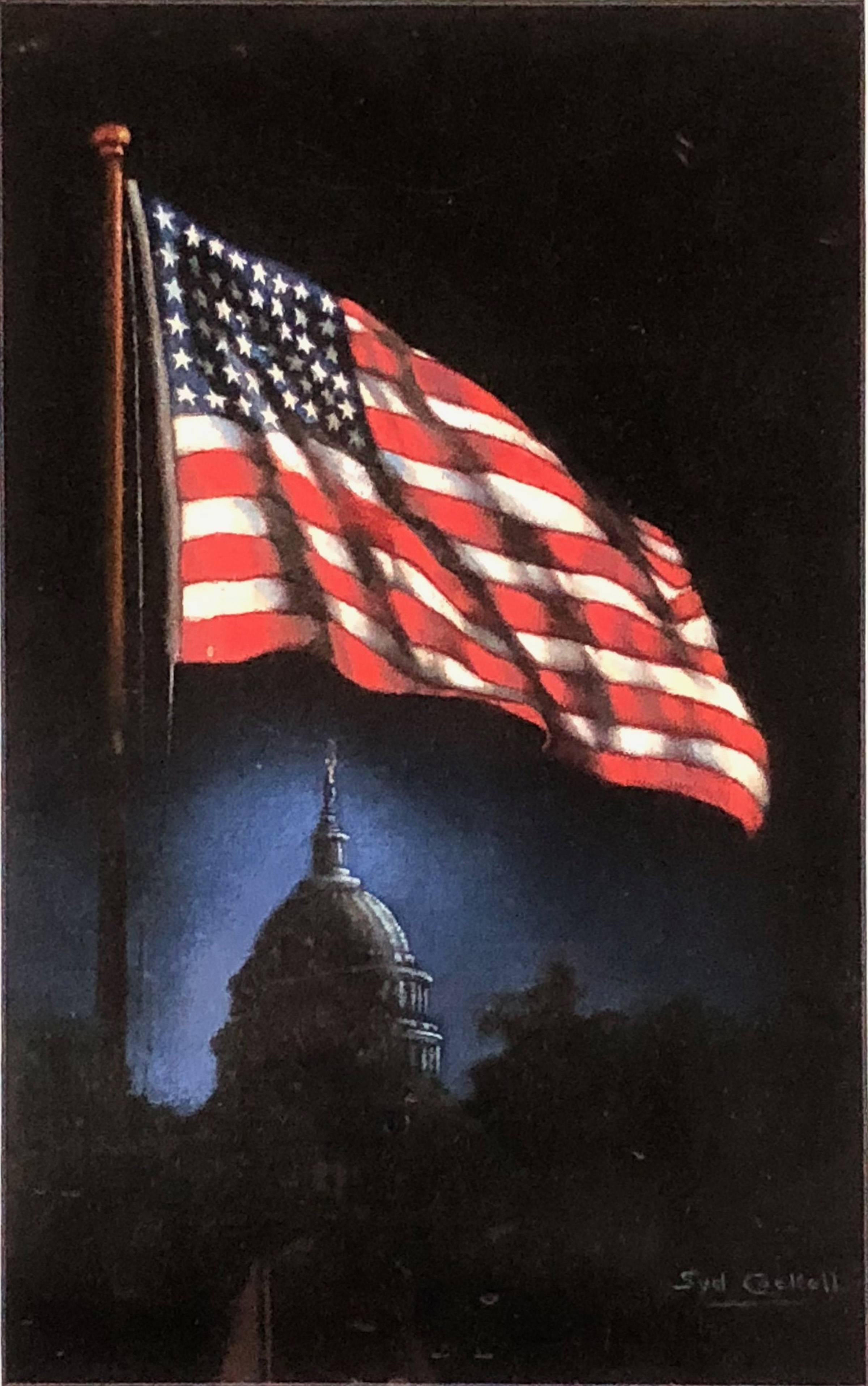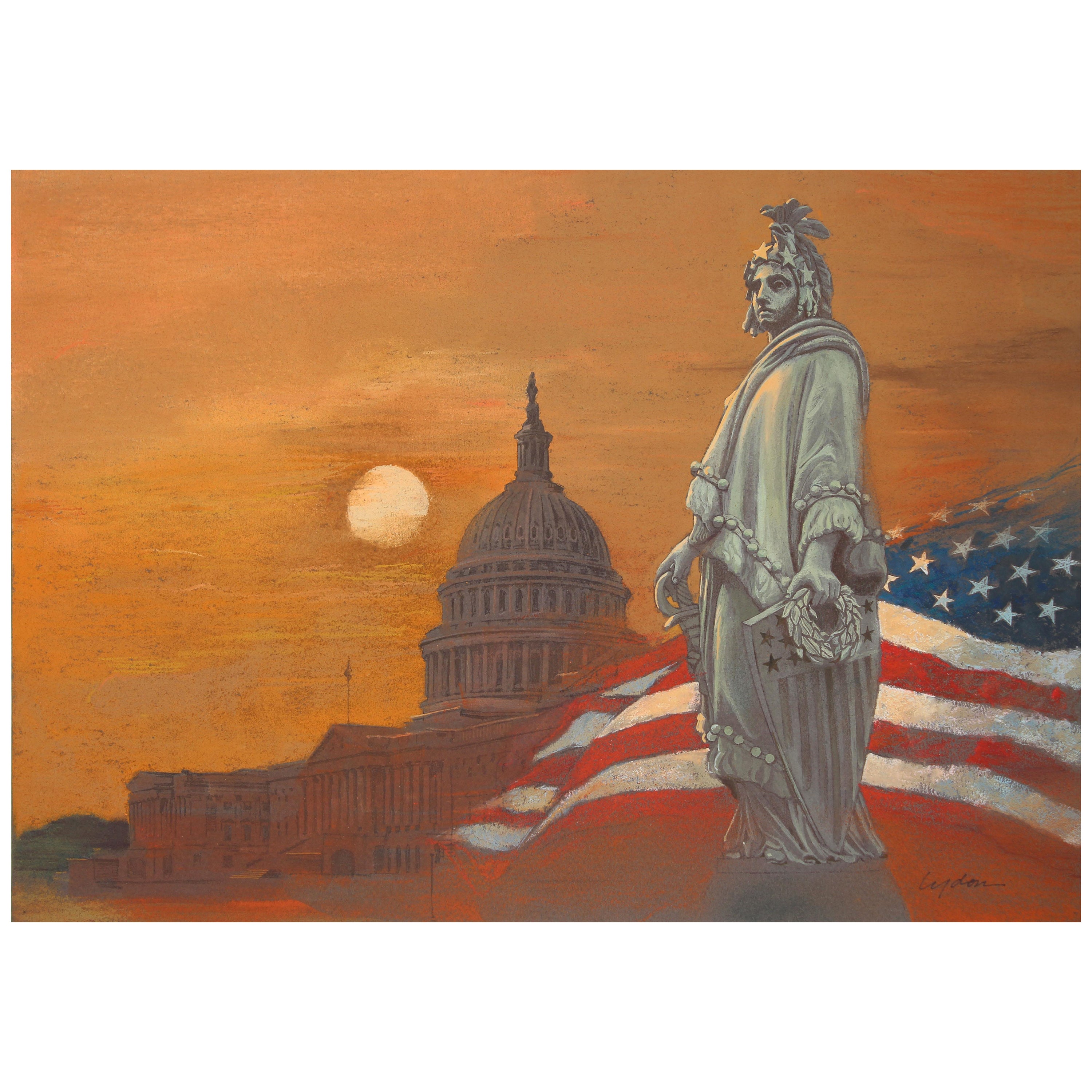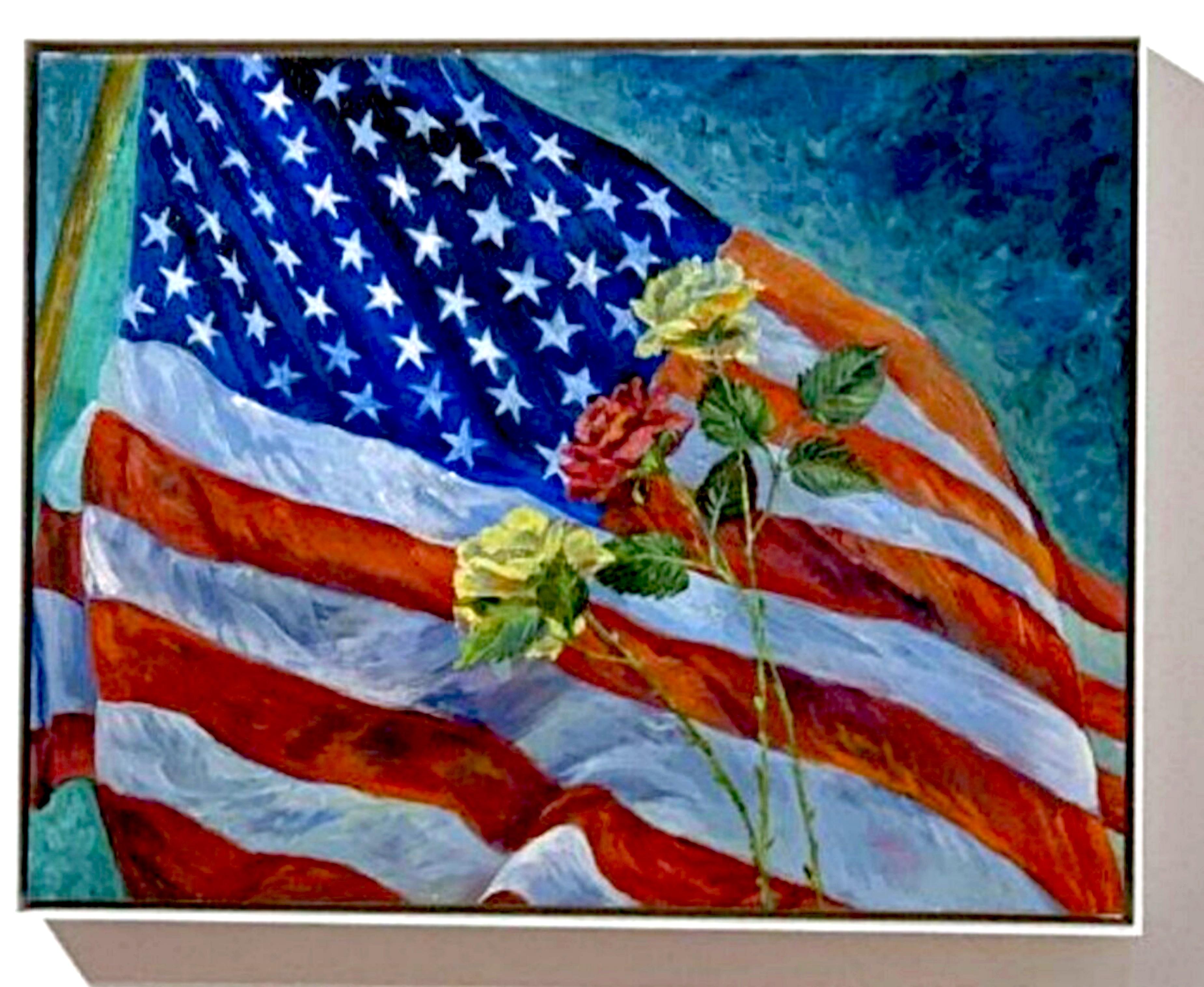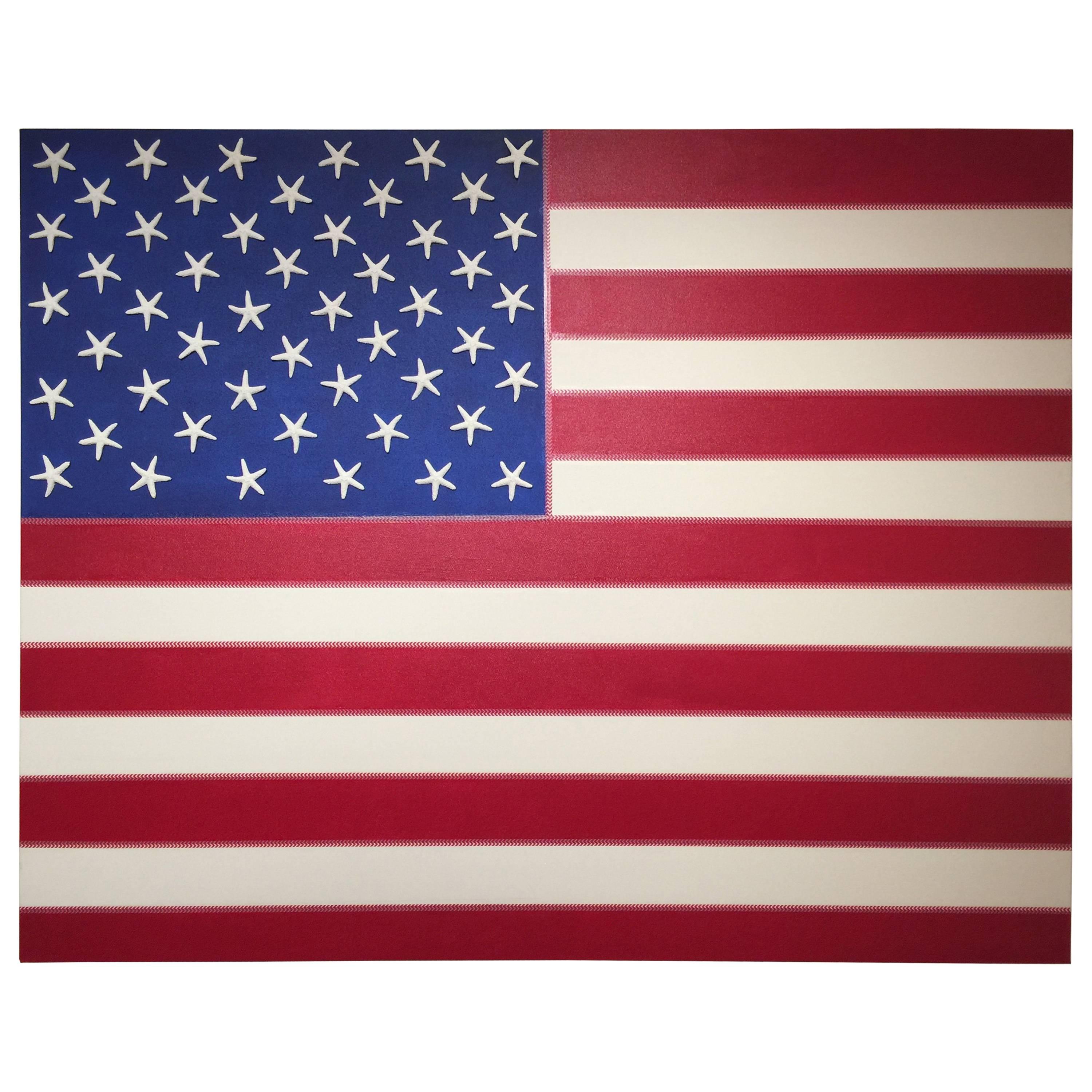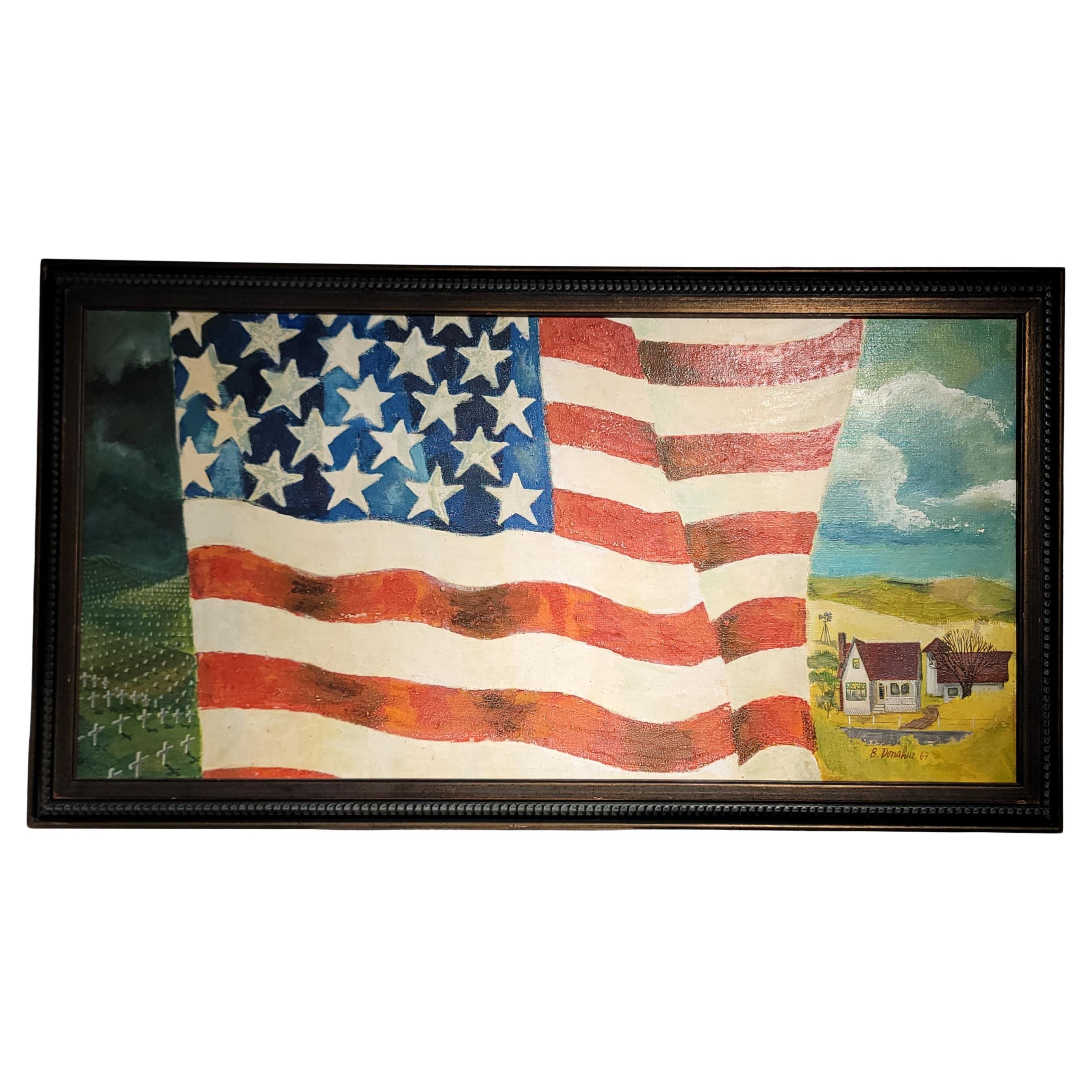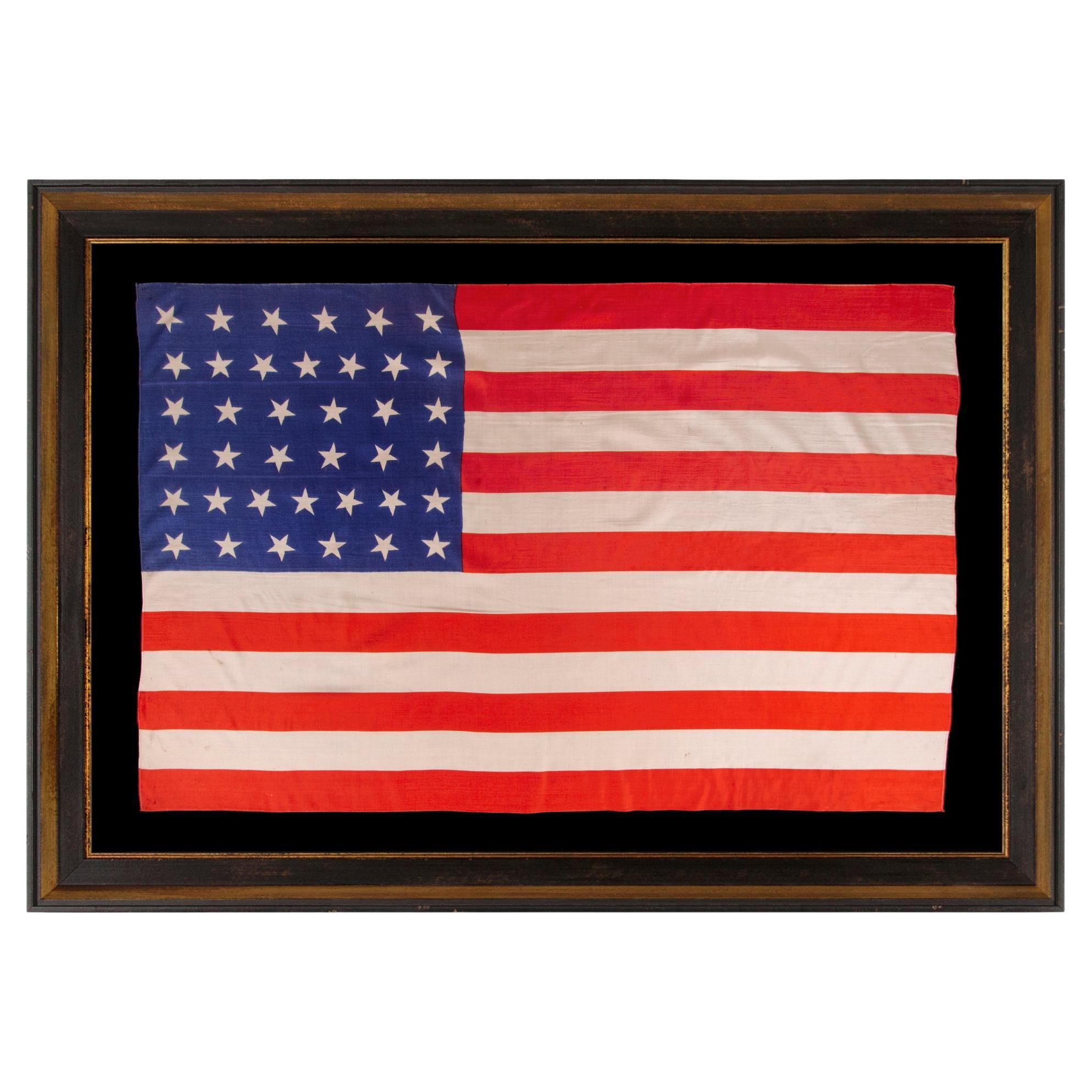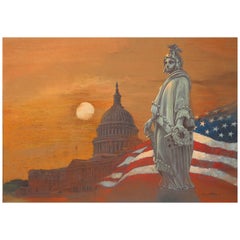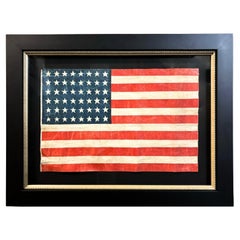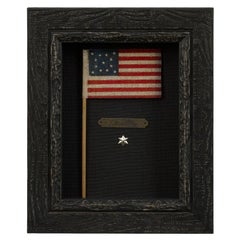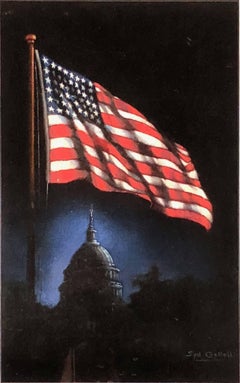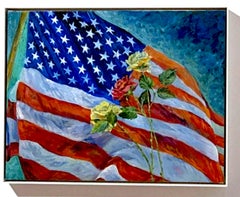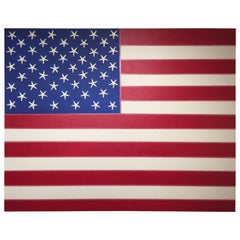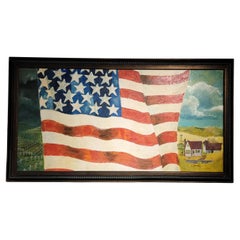Items Similar to "U.S. Flag Behind Capitol" by Ron Sloan, Mixed Media Painting, 1985
Want more images or videos?
Request additional images or videos from the seller
1 of 6
"U.S. Flag Behind Capitol" by Ron Sloan, Mixed Media Painting, 1985
$3,950
£3,015.81
€3,484.74
CA$5,545.05
A$6,180.54
CHF 3,242.72
MX$75,474.45
NOK 41,059.84
SEK 38,807.80
DKK 26,008.12
About the Item
Presented is “U.S. Flag Behind Capitol,” an original mixed-media painting by American artist Ron Sloan. The drawing shows an intricately detailed rendering of the front entrance to the United States Capitol building. Behind the Capitol is a large, waving American flag, set outside an orange-hued rounded rectangle. Sloan created this stunning artwork in February of 1985, for use on the Fleetwood First Day Cover of the 22 cent “Flag Over Capitol” stamp, issued in March of that same year.
The painting depicts the iconic neoclassical building from the east orientation, with it’s dome towering overhead. Plans began in May of 1854 to build a new cast-iron dome for the United States Capitol. The then-architect of the Capitol Thomas Walter and his team were sold on the aesthetics of a new dome, as well as the utility of a fire-proof one. A year later, on March 3, 1855, President Franklin Pierce signed off on the appropriation of $100,000 to build the dome. Construction began in September of that year with the removal of the first dome raised by Charles Bulfinch. Over the next 11 years, the dome rose over the nation's capital.
By December of 1863, Walter was able to set the bronze sculpture “Statue of Freedom” atop the dome. Thomas Walter resigned in 1865 and his replacement, Edward Clark, assumed the role of finishing the last aspects of the dome. Just over a month later, in January 1866, Constantino Brumidi, who had been hired to paint a fresco above the interior dome's oculus, removed the scaffolding used during his work on the Apotheosis of Washington. This signaled the end of construction for the United States Capitol dome.
A First Day Cover consists of an envelope and a stamp tied together by a theme, usually celebrating a historic moment or historical figure. Very collectible, First Day Covers feature a stamp canceled on its first day of issue and a large artistic cachet that usually fills most of the envelope. The artistry that goes into these envelopes is very impressive, as they have to celebrate a moment in history and compliment the art on the stamp. Fleetwood First Day Covers are produced for both commemorative and regular issue U.S. stamps of all denominations.
CONDITION:
Mixed- media painting on illustration board. Colors are vibrant. Signed in lower right of composition. Verso is stamped with several past collection stamps, including Unilever Corporation reference numbers and registrar information. Unframed. Image size: 17 1/2” H x 16 1/4”W. Paper size: 25 1/2” H x 19 3/4” W.
- Dimensions:Height: 25.5 in (64.77 cm)Width: 19.75 in (50.17 cm)Depth: 0.25 in (6.35 mm)
- Materials and Techniques:
- Place of Origin:
- Period:1980-1989
- Date of Manufacture:1985
- Condition:Wear consistent with age and use.
- Seller Location:Colorado Springs, CO
- Reference Number:Seller: PR4141stDibs: LU909738795822
About the Seller
4.9
Platinum Seller
Premium sellers with a 4.7+ rating and 24-hour response times
Established in 2010
1stDibs seller since 2011
461 sales on 1stDibs
- ShippingRetrieving quote...Shipping from: Colorado Springs, CO
- Return Policy
Authenticity Guarantee
In the unlikely event there’s an issue with an item’s authenticity, contact us within 1 year for a full refund. DetailsMoney-Back Guarantee
If your item is not as described, is damaged in transit, or does not arrive, contact us within 7 days for a full refund. Details24-Hour Cancellation
You have a 24-hour grace period in which to reconsider your purchase, with no questions asked.Vetted Professional Sellers
Our world-class sellers must adhere to strict standards for service and quality, maintaining the integrity of our listings.Price-Match Guarantee
If you find that a seller listed the same item for a lower price elsewhere, we’ll match it.Trusted Global Delivery
Our best-in-class carrier network provides specialized shipping options worldwide, including custom delivery.More From This Seller
View All"Statue of Freedom" by Tom Lydon, Original Chalk on Paper, 1991
Located in Colorado Springs, CO
Presented is “Statue of Freedom,” an original chalk drawing by American artist Tom Lydon. The drawing shows an intricately detailed rendering of the ...
Category
1990s American Paintings
Materials
Paper
48-Star Printed American Flag, Commemorating Arizona Statehood, 1912-1958
Located in Colorado Springs, CO
This is an original 48-star American parade flag, celebrating Arizona statehood. A wonderful product of our nation's early history, this flag is an authentic antique, with a fly date...
Category
Mid-20th Century American Political and Patriotic Memorabilia
Materials
Fabric
46-Star Printed American Flag Waver, Celebrating Oklahoma Statehood
Located in Colorado Springs, CO
Presented is an American flag waver with 46 stars. The printed flag features a row pattern of stars against a dark blue canton, with thirteen red and white stripes completing the des...
Category
Antique Early 1900s American Political and Patriotic Memorabilia
Materials
Fabric
13-Star Flag Waver for the Centennial Celebration
Located in Colorado Springs, CO
This small charming 13-star flag waver was made for and sold during the nation’s Centennial celebration in Philadelphia in 1876. All manner of flags were made for the official Centen...
Category
Antique 1870s American Federal Political and Patriotic Memorabilia
Materials
Fabric
31-Star Printed American Flag, Celebrating California Statehood, Circa 1850
Located in Colorado Springs, CO
This is a rare 31-star medallion printed American flag, celebrating the addition of California to the Union. The flag is printed on silk and has a spectacular “Great Star” canton pat...
Category
Antique 1850s American Political and Patriotic Memorabilia
Materials
Silk
Centennial Celebration "1776-1876" American Flag Banner
Located in Colorado Springs, CO
Presented is a rare Centennial patriotic flag banner, dating to 1876. The flag’s brilliant blue canton is spectacular, with 81 five-pointed, rayed stars, arranged to read “1776” and “1876.” The flag’s design is completed with thirteen alternating red and white stripes. The flag is a three-piece, treadle-sewn sewn construction, printed on a thin wool and cotton blend. Along the edge, there is a narrow, treadle-sewn sleeve made of cotton tape.
In the lead up to the nation’s Centennial in 1876, flag makers and individuals looked to the past for designs to produce as part of the country’s many celebrations. Popular interpretation of the stars and stripes undoubtedly reached its climax of variety and originality at the time of our Nation’s first Centennial. Since no design restrictions were placed on flagmaker’s imaginations and no strict distinctions were drawn between official and unofficial star counts, it is no surprise that, on the occasion of the Centennial, creativity in flag design was not the exception, but the rule.
The cantons from this period presented an array of geometric abstractions. Great star patterns, referred to as the “starry flower of Liberty” by Oliver Wendell Holmes, that were popular from 1818 and on, resurfaced in Centennial flags...
Category
Antique 1870s American Political and Patriotic Memorabilia
Materials
Wool, Cotton
You May Also Like
The Flag and Capitol
By Syd Cockell
Located in Missouri, MO
This is an original oil on velvet painting created c. 1942. Syd Cockell was an accomplished American illustrator during World War II.
Category
1940s American Realist Landscape Paintings
Materials
Oil
In Memoriam (American Flag), unique signed acrylic painting on canvas, Framed
By Thelma Appel
Located in New York, NY
Thelma Appel
In Memoriam, 2002
Acrylic on Canvas painting
Hand signed, dated and titled in black marker on the back
This is a unique work
Frame Included: elegantly framed in a hand m...
Category
Early 2000s Contemporary Figurative Paintings
Materials
Canvas, Acrylic
J. WOHNSEIDLER American Flag No. 1, 2017 Acrylic on Canvas
Located in New York, NY
American Flag No. 1 by J. Wohnseidler.
Arcylic on canvas with hand-applied starfish.
Unframed.
Signed/titled/dated by artist on back.
Measures: 48 inches L x 36 inches H x 1.5 inches D.
Category
2010s American Contemporary Art
Materials
Canvas, Acrylic
Signed Dated Patriotic American Flag Painting
Located in Los Angeles, CA
Signed B. Donahue and dated 1969 Patriotic Flag painting.
On the left side a cemetery honoring fallen heroes in war. To the Right of the flag is a seemi...
Category
Vintage 1960s American Adirondack Paintings
Materials
Canvas
38 Star Antique American Flag, Colorado Statehood, circa 1876-1889
Located in York County, PA
38 star antique American parade flag with scattered star orientation, made of silk, with generous scale and vivid colors, Colorado Statehood, 1876-1889
38 star American national p...
Category
Antique Late 19th Century American Political and Patriotic Memorabilia
Materials
Silk
Price Upon Request
"Stars and Stripes" Americana Pop 23 Karat Gold Leaf/Red/Blue Oil, Flag Painting
By Charlotte Andry Gibbs
Located in Wellesley, MA
"Stars and Stripes"
23 Karat Gold Leaf and Oil on Linen
26 x 50 Inches
Charlotte Gibbs’ "flag" and "star" paintings often reference the artist's interest in Pop art and sometimes incorporate 23 karat gold leaf in addition to oil paint, but not always. With its depiction of a graphically idealized American flag.
"Stars and Stripes" is at once lovely and bold. Beautifully painted and exquisitely executed, these elegant works of rich color are sophisticated examples of Gibbs' ability to invoke whimsy while demanding serious attention, and the artist's simple distressed white wood double lattice frame is the perfect complement.
Also available is a smaller version of this painting, "American Standard" 18 x 34 inches, as well as a vertical variation "Vertical U.S. Flag" 34 x 18 inches. Additional variations of the American flag series are available without 23 karat gold leaf ("Reverse Image" in black and white, "Flag #4" in black, white and tan, and "Black and White" which is
black, gray and white).
The artist's "Canton" series of paintings focuses on stars only. Paintings from this series are available in navy blue with gold leaf stars ("Canton Major" 34 x 48 Inches), olive drab with gold leaf stars ("Canton Olive and Gold" 30 x 42 Inches), and all 23 karat gold leaf ("Starry Splendor" 30 x 42 Inches).
Gibbs is often commissioned to paint variations on her 'flags' and 'stars' to customize scale, orientation (horizontal or vertical) palette, and/or symbols of particular significance to the client.
Additionally available are flag paintings in various sizes inspired by the British flag with and without 23 karat gold leaf ("Sgt. Pepper Jack," "Union Jack Red and Gold," "Union Jack Navy and Gold," and "Union Jack White and Gold"), the Scottish flag...
Category
2010s Pop Art Figurative Paintings
Materials
Gold Leaf
More Ways To Browse
Hand Painted Ties Vintage
Off Round Hue
Yves Saint Laurent Birds
1930s Antique Clocks
Antique Cravat
Antique Fireplace Clock
Antique Gables
Antique Hawaiian Art
Antique Leather Desk Pad
Antique Plaster Wall Sculpture
Antique Spirit Board
Antique Statue Clocks
Antique Wall Crucifix
Antique Walnut Writing Slope
Antique Wicker And Rattan
Art Nouveau Water Lily
Asia Erotic
Asian Carved God
